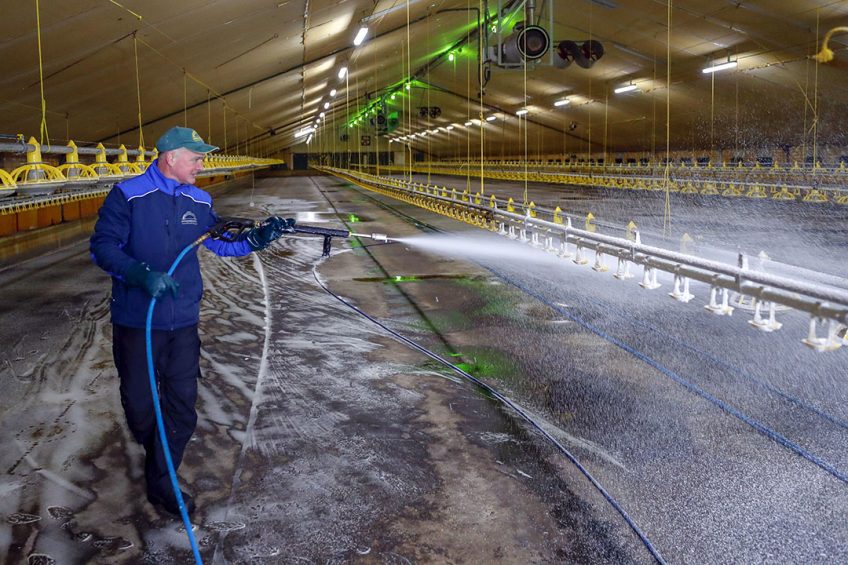VIR Check helps to lower viral pressure in poultry houses

A new test enables broiler farmers to measure the results of the cleaning and disinfection of their poultry houses. It shows just how effective the process of cleaning poultry houses actually is in between rounds. The Dutch animal health service GD is debuting its VIR Check worldwide.
Broiler farmers devote a lot of time to cleaning and disinfecting their poultry houses after delivering a flock. It takes days and has just one purpose: to make sure that the new chicks arrive in a comfortable and pathogen-free environment. The effectiveness of the process is not always clear.
“If a poultry house looks clean at first glance, that does not mean it is actually spotless,” says Sjaak de Wit, poultry vet and researcher at Royal GD in the Dutch town of Deventer. “The traditional method for checking cleanliness using ‘Rodac plates’ does not provide conclusive information. Rodac plates are used to determine whether easily growing bacteria are still present in the poultry house. The principle is that if you find such bacteria, there will also be viruses left in the poultry house. However, if you do not find these bacteria, there is no guarantee that all the viruses have also gone.”
To determine the effect of the cleaning and disinfecting process on viruses, GD has developed its own VIR Check. This test focuses on ‘naked viruses’. As De Wit explains, “‘naked’ suggests that you can easily eliminate them by cleaning and disinfecting the poultry house. However, the opposite is true. Naked viruses are generally very resistant to cleaning and disinfecting. This is not the case with viruses encased in an envelope. These viruses have a layer of fat on the outside which makes them vulnerable to soap and disinfectant”. Examples of naked viruses are reoviruses, the Gumboro virus, rotaviruses and astroviruses. Unlike bacteria, viruses cannot just be picked up from the floor or wall for examination, so VIR Check uses material in the cloacas of week-old chicks. “When an animal is infected, it quickly produces more virus in just a week’s time. That’s why we carry out our measurements at 6 or 7 days old,” says De Wit.
We do not need to convince anyone of the importance of thorough cleaning and disinfection,” – Janny Hermans, poultry vet.
Field trial
GD started a field trial several months ago in cooperation with De Hoop Mengvoeders, AdVee Veterinarians and 22 broiler farms. Its aim was to discover whether the VIR Check score also has a predictive value for the flock’s technical results. The first round results at the 22 participating farms are in, while the second round is still ongoing at most farms, so these results have not yet been disclosed.
Flamur Llapashtica, poultry specialist at De Hoop Mengvoeders, has already noticed that the tests lead to greater awareness. “One poultry farmer’s first round results were all green because he had organised everything very well. In the second round, the result from one of his poultry houses was dark red. It appeared that he had not soaked the poultry house prior to cleaning it before the second round. He had also used a different disinfectant in a lower concentration. This confirmed what he already suspected: the score went up rapidly. This system more clearly shows the effect of what you are doing.”
“We do not need to convince anyone of the importance of thorough cleaning and disinfection,” AdVee Veterinarians poultry vet Janny Hermans adds. “When the results are insufficient, there may be 4 or 5 viruses lying in wait for the new one-day old chicks. That doesn’t mean the chicks will get sick, but controlling these viruses depletes their energy and affects growth.”
 Poultry disease prevention by design
Poultry disease prevention by design
Disease prevention is certainly very much to the fore, as it is such an integral part of sustainable poultry production.
No grade
Hermans emphasises that a VIR Check result is not a grade for broiler farmers. “When VIR Check shows red, that does not mean the farmer didn’t do a good job. We can say, however, that the cleaning and disinfecting were not successful. This is often the case because it can be very difficult to thoroughly clean a poultry house. Seams, cracks and floors especially are not easily cleared of pathogens.” The trial results do not translate into a checklist for cleaning and disinfection that every broiler farmer should use. “It’s not that simple,” says Llapashtica. “Every farm is different. The trial with VIR Check does indicate however that even small adjustments to the cleaning and disinfecting process can have a major impact.”
 Antibiotic Reduction Special
Antibiotic Reduction Special
Moving away from antibiotics can be challenging and requires a new way of thinking about biosecurity. Here the latest methods for raising healthy livestock without the use of preventive antibiotics are explored.
Little attention for empty period
Llapashtica concludes that VIR Check is an additional aid that can be used to work towards better results. “The empty period deserves more attention at many farms. Every farmer has their own approach and protocol for end of flock, cleaning and disinfecting poultry houses. The VIR Check field trial shows that improvements can be made in many situations. It is often a matter of dotting the i’s and crossing the t’s. Soaking poultry houses before spraying is very important, but that can sometimes be overlooked. The length of the empty period is a significant factor as well.”
Another goal of the field trial is to investigate whether a good VIR Check score in 6 to 7-day-old chicks has an effect on the technical results and the slaughter process, for example, in terms of better gut health and conformation. These technical and slaughter results have not yet been processed.
Llapashtica and Hermans share the view that the field trial confirms that VIR Check is a good tool for broiler farm management. “Over the last few months we have noticed that broiler farmers are very enthusiastic about it,” Hermans commented. “Checking cleaning and disinfection with this new test appears to motivate farmers. They are very curious about the results and actively improve their routines to obtain a better score in the next round.”
The new test is also useful for farms with slow growing broilers. “The prevailing thought is that pathogens do not play a large part at broiler farms. This is not correct, however. Especially with slow growers, an infection of one-day chicks with reoviruses, for example, can have a major impact on growth.”
VIR Check indicates 5 virusesVIR Check is a tool which can be used to ascertain whether the cleaning and disinfecting process in a poultry house was successful. This test determines the viral pressure in a broiler house. Cloaca swabs provide the basis for the test. The broiler farmer or vet takes swabs from 6 to 7-day-old chicks and transfers them to an FTA card for testing and shipment purposes. VIR Check indicates the presence and amount of five contagious viruses: rotaviruses A and D, chicken astrovirus, aviary nephritis virus 3 and reovirus. VIR Check shows three results: green, orange and red. Green indicates that the cleaning and disinfection process in the poultry house was successful. Orange is the score most broiler farms achieve. Red is a signal that cleaning and disinfection need more attention. VIR Check costs € 89. |
Join 31,000+ subscribers
Subscribe to our newsletter to stay updated about all the need-to-know content in the poultry sector, three times a week. Beheer
Beheer











 WP Admin
WP Admin  Bewerk bericht
Bewerk bericht